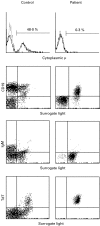Complete arrest from pro- to pre-B cells in a case of B cell-negative severe combined immunodeficiency (SCID) without recombinase activating gene (RAG) mutations
- PMID: 11472408
- PMCID: PMC1906068
- DOI: 10.1046/j.1365-2249.2001.01553.x
Complete arrest from pro- to pre-B cells in a case of B cell-negative severe combined immunodeficiency (SCID) without recombinase activating gene (RAG) mutations
Abstract
The B-cell lineage in a patient with B-cell-negative severe combined immunodeficiency (SCID) was analysed by using antisurrogate light chain (SL) MoAbs. Peripheral CD3(+) T cells and CD19(+) B cells were absent in the patient. The common gamma (gamma c) chain was expressed normally on the patient's peripheral NK cells and his peripheral mononuclear cells did not possess any mutations in recombinase activating gene (RAG)-1, 2. Normal levels of expression of Ku70 and Ku80 protein were found by Western blot analysis. The patient did, however, display an increase in fibroblast sensitivity to irradiation. Furthermore, flow cytometric analyses of bone marrow cells showed that surface IgM and cytoplasmic mu positive cells were absent and that CD19(+) B cells were composed of only CD34(+) terminal deoxynucleotidyl transferase (TdT)(+) SL(+) pro-B cells. The complete arrest of pro- to pre-B cell development in the SCID patient's bone marrow suggests that some genes involved in V(D)J recombination, excepting the RAG gene, may play a causative role in the immunodeficiency.
Figures




References
-
- Smart BA, Ochs HD. The molecular basis and treatment of primary immunodeficiency disorders. Curr Opin Pediatr. 1997;9:570–6. - PubMed
-
- Buckley RH, Schiff RI, Schiff SE, et al. Human severe combined immunodeficiency: genetic, phenotypic, and functional diversity in one hundred eight infants. J Pediatr. 1997;130:378–87. - PubMed
-
- Leonard WJ. The molecular basis of X-linked severe combined immunodeficiency: defective cytokine receptor signaling. Annu Rev Med. 1996;47:229–39. - PubMed
-
- Schwarz K, Gauss GH, Ludwig L, et al. RAG mutations in human B cell-negative SCID. Science. 1996;274:97–9. - PubMed
Publication types
MeSH terms
Substances
LinkOut - more resources
Full Text Sources
Medical
Research Materials

